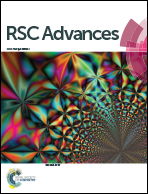A phenanthroline-derived ligand and its complexation with Pd(ii): from ligand design, synthesis and Pd(ii) complexes structures to its application†
Abstract
A novel phenanthroline-derived bis-opened-triazine ligand for selective complexation with Pd(II) over 19 typical metals from HNO3 media was designed based on cavity modulation strategy. Structures of the three species of the Pd(II) complexes of with the ligand were elucidated by 1H NMR titration isothermal titration calorimetry (ITC) and density functional theory (DFT) studies. ITC test and binding energy calculations demonstrated that the asymmetrical 1 : 1 Pd(II)–ligand complex with a monodentate nitrate anion was the most stable among these three species of the Pd(II) complexes. The excellent kinetics of Pd(II) extraction with the ligand is due to its optimal conformation completely ready for metal ligation. The enhanced special extraction selectivity and fast extraction rate towards Pd(II) achieved by the phenanthroline-derived ligand demonstrated that the effective separation of some radionuclides with smaller radius in HLW through cavity modulation strategy is a feasible approach.


 Please wait while we load your content...
Please wait while we load your content...